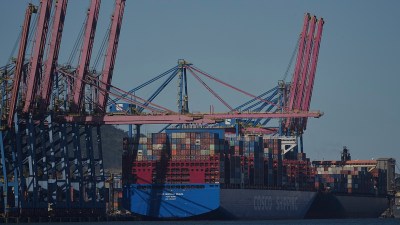Know Your City: Surat Fort tells tale of a once-thriving port city that travellers marvelled at
The Surat Municipal Corporation took up restoration of Surat Fort in 2015 and completed the project in two phases at a cost of Rs 53 crore.
 The Surat fort precinct has six buildings, four bastions and a moat with a drawbridge merging architectural styles of the Tughlaq, Gujarat Sultanate, Mughal, Dutch and British eras. (Express photo by Hanif Malek)
The Surat fort precinct has six buildings, four bastions and a moat with a drawbridge merging architectural styles of the Tughlaq, Gujarat Sultanate, Mughal, Dutch and British eras. (Express photo by Hanif Malek) Located on the bank of the Tapi river that meets the sea, Surat was once a thriving port trading with 84 countries in every kind of commodity. The Surat Fort or the Surat Castle, built in the style of a castle and surrounded by a moat, was meant to guard the port city against invaders, mainly the Portuguese.
It is 18 metres high with four bastions and four-metre-thick brick walls fastened with iron strips and molten lead. During the restoration, taken up in 2015 by the Surat Municipal Corporation (SMC), it was found that a smaller version of the fort existed, probably dating back to 1372 to the Tughlaq era, which was later expanded.
However, after the Portuguese burnt Surat down in 1512 and raided it in 1530, the Sultan of Gujarat Mahmud Shah III, who was based in Ahmedabad, assigned the then Surat governor, a Turkish soldier called Nazim Khwaja Safar Salmani, to build a stronger and bigger fort to protect the citizens and traders. Salmani, entitled ‘Khudavand Khan’ in 1540 CE by the Sultan, began the construction of the fort in 1546.
The fort precinct has six buildings, four bastions and a moat with a drawbridge merging architectural styles of the Tughlaq, Gujarat Sultanate, Mughal, Dutch and British eras. Inside, the fort has barracks, guardrooms, hamam khana (bathroom), a sepoy chowky area, watch towers, a water tower, a laboratory, a prison, and so on.
 It is 18 metres high with four bastions and four-metre-thick brick walls fastened with iron strips and molten lead. (Express photo by Hanif Malek)
It is 18 metres high with four bastions and four-metre-thick brick walls fastened with iron strips and molten lead. (Express photo by Hanif Malek)
An official at the fort said the moat and drawbridge had disappeared, but while accessing various archives and records during restoration, its exact location and records were found. The moat was excavated and revived, and a specially designed hydraulic drawbridge was installed.
The official shared how, during the restoration process, “secret vaults” were discovered inside the fort that has a ventilation system through which “cold air enters from the bottom and hot air evacuates from the top of the room”.
It is designed in such a way that these channels are not visible from the outside. Similar channels were made to provide hot water into the hamam khana, and wastewater was discharged from other channels.
According to the SMC, the fort wall is 20 yards (18 metres) from the ground level and 4.06 metres wide. Baked bricks and limestone were used to construct the wall.
As per SMC records, the fort was in its original state till 1921. Khudavand Khan had brought cannons from Junagadh and installed them on the fort’s walls. After a month-long battle, Akbar invaded the fort in 1573 and set up a tax collection centre for ships and traders from outside.
 Baked bricks and limestone were used to construct the wall. (Express photo by Hanif Malek)
Baked bricks and limestone were used to construct the wall. (Express photo by Hanif Malek)
Iranian historian Mulla Muhammad Amin Astrabadi described the fort as one that “paradise would feel jealous of”. In 1759, the Britishers took charge of Surat Castle and ran their administrative offices, coordinating with other offices in different parts of Surat city and neighbouring districts.
Accounts of historians and travellers, including Portuguese traveller Duerte Barbosa, describe how Surat was famous for trade in spices, wheat, indigo, medicines, ivory, copper, bronze, etc., in the 16th to 18th centuries. They would come to Surat from various parts of India and be exported to other countries. Surat flourished during the earlier centuries and attracted invaders from other countries.
Several Dutch, Portuguese and British travellers have mentioned the prosperity of Surat in accounts they wrote after visiting Surat. Pietro Della Valle, an Italian composer, musicologist, author, and traveller who toured throughout Asia during the Renaissance period, came to Surat in 1823-1824 and praised the trade activity with other countries.
Antonio Monserrate, a Portuguese priest accompanied by two other priests, was the first Jesuit in Akbar’s court and wrote about his visit to Surat in 1579-1580: “Merchants throng Surat and the nearby ports are full of ships, for it is a safe anchorage since the river extends deep and broad from the sea right up to the city. The citizens had defended themselves most manfully against the Portuguese, although they have been overcome”.
The Monserrate Commentary states: “Surat stands on the river Taphaeus (later Tapi), which enters the sea six miles from the town. The citadel is in a naturally strong position, is well fortified, and is guarded by a garrison of two hundred mounted archers.”
 Several Dutch, Portuguese and British travellers have mentioned the prosperity of Surat in accounts they wrote after visiting Surat. (Express photo by Hanif Malek)
Several Dutch, Portuguese and British travellers have mentioned the prosperity of Surat in accounts they wrote after visiting Surat. (Express photo by Hanif Malek)
Padre Sesuita Manuel Godinho, another traveller, who stayed in Surat in 1662-63 on his way from Goa to Portugal, called Surat a “celebrated emporium”, “rather narrow city surpassing our Evora (a Portuguese city) in grandeur”, “a great market of India”, or “perhaps the richest city in the world”.
Vessels were continuously coming from Europe, Africa, Persia, and every part of India, as per manuscripts depicted in the fort by the SMC. After the British, offices of departments of Surat administration, including police stations, treasury, revenue, mamlatdar, and so on, operated out of the fort. But with the absence of proper upkeep, the fort’s condition deteriorated.
In 2015, the then chief minister of Gujarat, Anandiben Patel, during her visit to Surat to inaugurate the redeveloped Gopi Talav, saw the condition of the Surat fort and decided to hand it over for restoration and maintenance.
Bhamini Mahida, curator of Surat Fort, Museum and City Science Centre, said, “Before we took possession of the fort, over 70 offices were running there. We took possession of the entire fort by vacating them and giving our open plots to them.”
The SMC first hired a consultancy firm, People for Heritage, and later awarded the restoration contract in 2016 to the Surat-based Savani Heritage Conservation Pvt Ltd, which has also restored the cellular jail in Andaman and Nicobar Islands.
A total of Rs 53 crores were spent on the restoration work. Mahida said, “The fort was restored to its original form and while repair work was done at some places, in a bid to depict it in the original structure.”
The first phase of work was completed in 2018 and inaugurated by then deputy chief minister Nitin Patel, and the second phase in 2022, virtually inaugurated by Prime Minister Narendra Modi on September 29, 2022.
 The fort saw 61,892 visitors till August 2023 this year. (Express photo by Hanif Malek)
The fort saw 61,892 visitors till August 2023 this year. (Express photo by Hanif Malek)
Sumesh Modi from People for Heritage told The Indian Express, “The restoration work done in the fort is one of its kind, never done in any other part of India. We have done thorough research through experts and documents we got from different sources across the country, the British Library, a library in Japan, etc. When we took possession of the fort, we found it in pathetic condition, as it had been used for 70 years by different government offices. We have restored it with the same old fabric. Over 95 per cent of the original items of the old monument were reused. There were damages found in different parts; we got it repaired in the same old construction style using lime. After the Sultanate period, a lot of changes were made by Moghuls and then by Britishers, and we worked to keep the original structure. We are happy to take up such a project, and it is soul-satisfying work.”
“In its approximate 700-year-old history, the fort’s primary structure has been altered many times. After conducting thorough research on every construction style and technique of various time periods, a composite method was adopted to highlight major findings and restore the fort,” says Professor and historian Mohan Meghani of Surat.
The fort stands out from all other historical monuments not only because it has protected its rulers and citizens but also because, in its golden days, it protected ships arriving at Surat from 84 different ports, businessmen and trading commodities, adds Meghani. The modern amenity added was air conditioning for the comfort of tourists.
The fort saw 61,892 visitors till August 2023 this year. The precinct has an ivory articles gallery, a stones sculpture gallery, British-Japanese-Chinese porcelain and a fake and reproduction porcelain gallery, ancient wood art gallery, a philately gallery, an unani dispensary, a ritual bronze gallery, an arms and armour gallery, a Mughal gallery, a coins and currency gallery, a pots and jars gallery, Dutch and British lifestyle gallery, courtroom, manuscripts and miniature gallery, stone inscription and oil painting gallery, among others.












